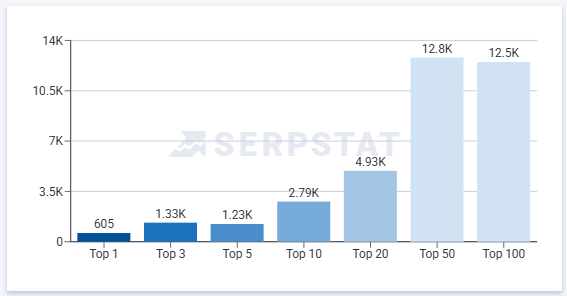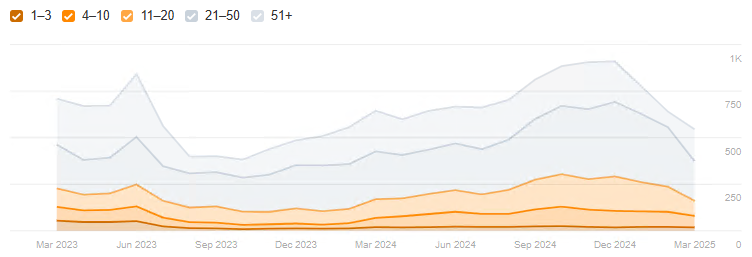Contents of the case

Media


Initial data
Whole works
- /01Increase sales
- /02Increase organic traffic
- /03Promote priority requests
Issues and overall strategy
We were approached with a clear problem – a significant drop in organic traffic and search engine rankings after the removal of a blog on the site. Previously, the blog played an important role in the site’s structure: thanks to internal linking, it maintained positions for priority service pages. However, after it was removed, traffic dropped sharply, and the number of requests for printing services decreased along with it. The main goal of the client was to return the lost traffic, restore positions in search engines, and, as a result, increase the number of requests from potential customers.
Before we started working with them, the printing house’s website was not systematically promoted. At the time of the start of the work, we conducted an audit and identified a number of problems. From a technical point of view, the site had numerous errors that required immediate correction – for this purpose, we drew up a detailed technical task for programmers (TAT). In terms of SEO, the basic framework was present, but it needed significant improvement. In particular, the site structure was underdeveloped, the key queries were outdated, and the meta tags and texts were irrelevant. This created obstacles to effective ranking in search engines.
After analyzing the situation, we approved a comprehensive strategy that takes into account both short-term needs (bug fixes) and long-term goals (traffic and application growth). Main areas of work:
- Updating the semantic core. We started by revising the key queries, as the previous list did not reflect current search trends and the needs of the print shop’s audience. Expanding the semantics will allow us to cover new niches and attract additional targeted traffic.
- Work with the site structure. Since the old structure did not meet the full potential of the business, we planned to expand it. This will help cover more requests and make the site more convenient for users and search engines.
- Restoring the blog. The removal of the blog was a critical blow to our position, so we decided to bring this section back. The new blog will be filled with high-quality content with internal linking that will support the main commercial pages.
- Link profile. To increase the authority of the site, we launched a campaign to build external links through outreach (publications on thematic platforms), crowd marketing (discussions on forums and in comments), and sabbaticals (registration in directories).
- Technical optimization. Eliminating bugs, speeding up page loading, fixing broken links, and other technical improvements became the basis for further promotion.
What was done
Technical optimization
The printing house’s website runs on a self-hosted admin panel, which complicated some aspects of the work, but did not become a serious obstacle. At the start, we conducted an audit using Screaming Frog, identified and fixed critical errors on the site. Additionally, we checked the site through validators, eliminating technical flaws. We paid special attention to the loading speed, optimizing it for better user experience and search engine rankings. We also adjusted the robots.txt file to properly manage indexing and set up automatic sitemap generation to facilitate search engine crawling. After analyzing competitors’ websites, we added new blocks to the pages that helped to better disclose the services of the printing house.
Semantics and ranking
At the time of launch, the site was ranked for 32 thousand keywords, mostly information queries from the blog, but also some commercial ones. The client had a semantic core (SC), but it was incomplete. We took it as a basis, updated the semantics on the existing pages, and started expanding. The emphasis was on high-frequency (HF) and medium-frequency (MF) queries, as they had a greater potential for attracting targeted traffic. Priority queries, such as “typography” or “printing house,” turned out to be highly competitive, which required careful work on content and links.
Website structure
The site structure was small and expandable. The level of nesting is only one step: from the home page to the service page. There were no categories and subcategories, which simplified navigation but did not allow for full coverage of all the semantic core query clusters. This became one of the project’s limitations, which we took into account in our further strategy.
Content
The content part of the project began with an analysis of competitors’ texts. Based on this, we adjusted the existing texts on the site, and in some cases wrote new ones if the old ones did not meet the promotion goals. Images with alt tags were added to the texts to improve indexing and visibility in image search. We also added FAQ blocks to the pages to help answer frequently asked questions and further optimize the content for information requests.
Usability
To improve the user experience, we added new information blocks, for example, about print runs and printing features. We also implemented conversion forms, such as the “Consultation” button and a feedback form, to make it easier for potential customers to interact with the site and increase sales.
Structured data
The main structured data on the website was already set up before we started our work. However, after adding the FAQ block, we expanded the micro-markup so that search engines better understand the structure of the content and display it in extended snippets.
Link profile
The external promotion strategy was developed based on the analysis of competitors. We attracted links through outreach (high-quality guest posts), crowd marketing (discussions on forums and in comments), and submissions (registration in directories). The latter were used mainly to increase the site’s Domain Rating (DR). This approach allowed us to gradually increase the site’s credibility in the eyes of search engines.
Results
Promoting a printing house website was an interesting challenge due to the high competition in the niche and limitations such as a small structure and incomplete semantic core. Nevertheless, we conducted a comprehensive technical optimization, expanded the semantics, improved the content and usability, and strengthened the site with external links. The work paid off: the site strengthened its position in key queries and became more user-friendly. This case study demonstrates how a systematic approach to SEO can work even with small projects in competitive niches.
| Options | At the beginning of the work | After 16 months | Difference |
|---|---|---|---|
| Organic traffic | |||
| Organic traffic | 1360 | 1576 | +15,88% |
| Keywords in the top 10 | |||
| Keywords in the top 10 | 166 | 252 | +51,81% |
| Visibility | |||
| Visibility | 0,3 | 0,52 | +73,33% |




